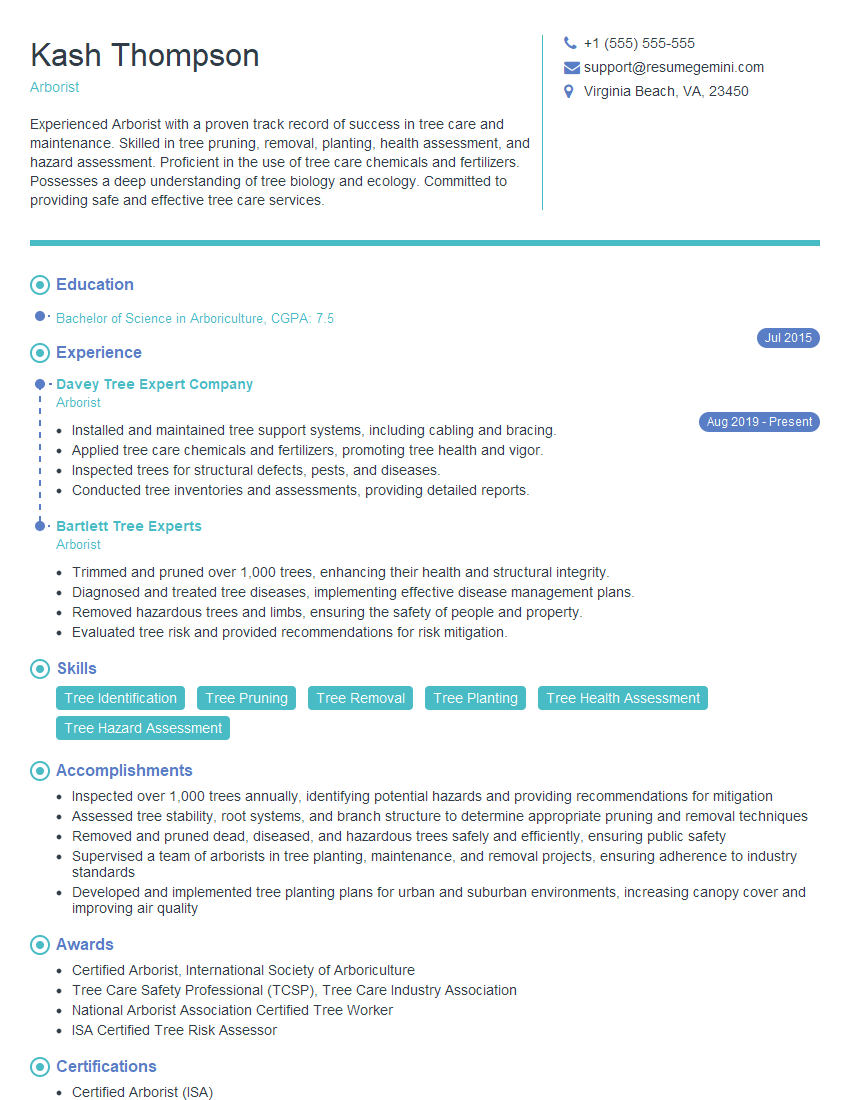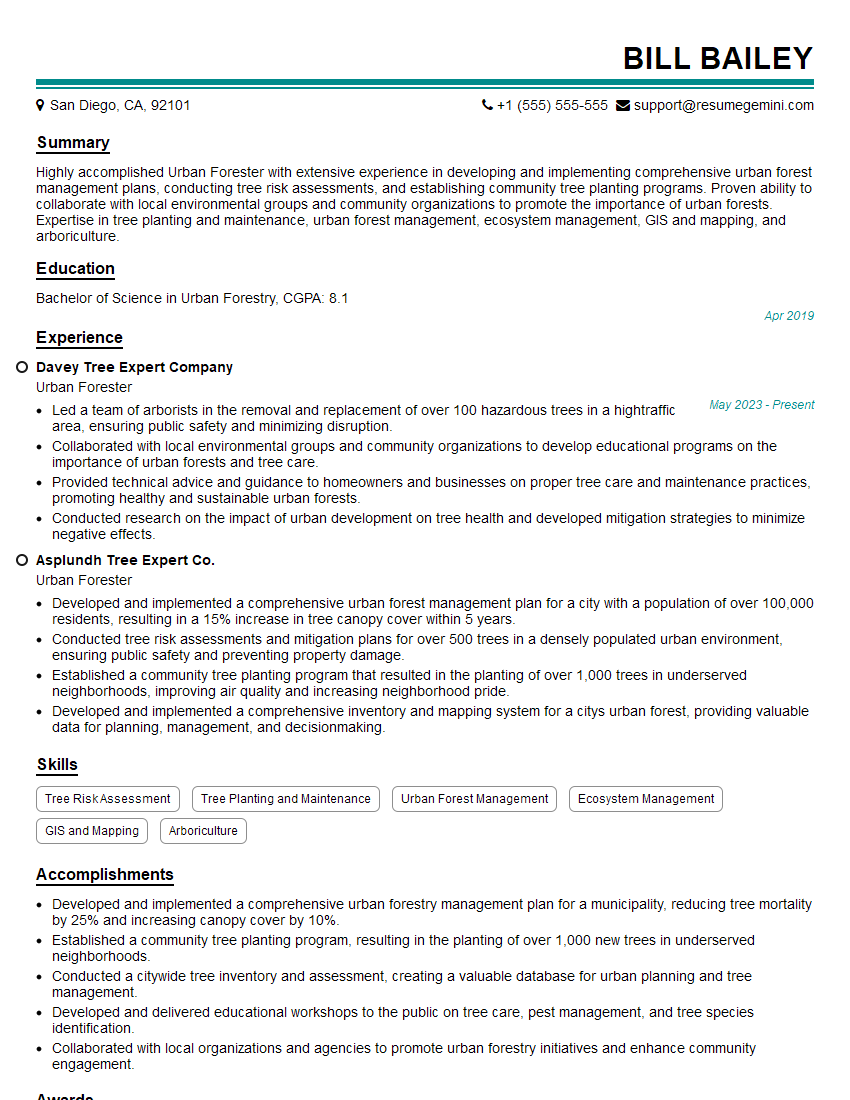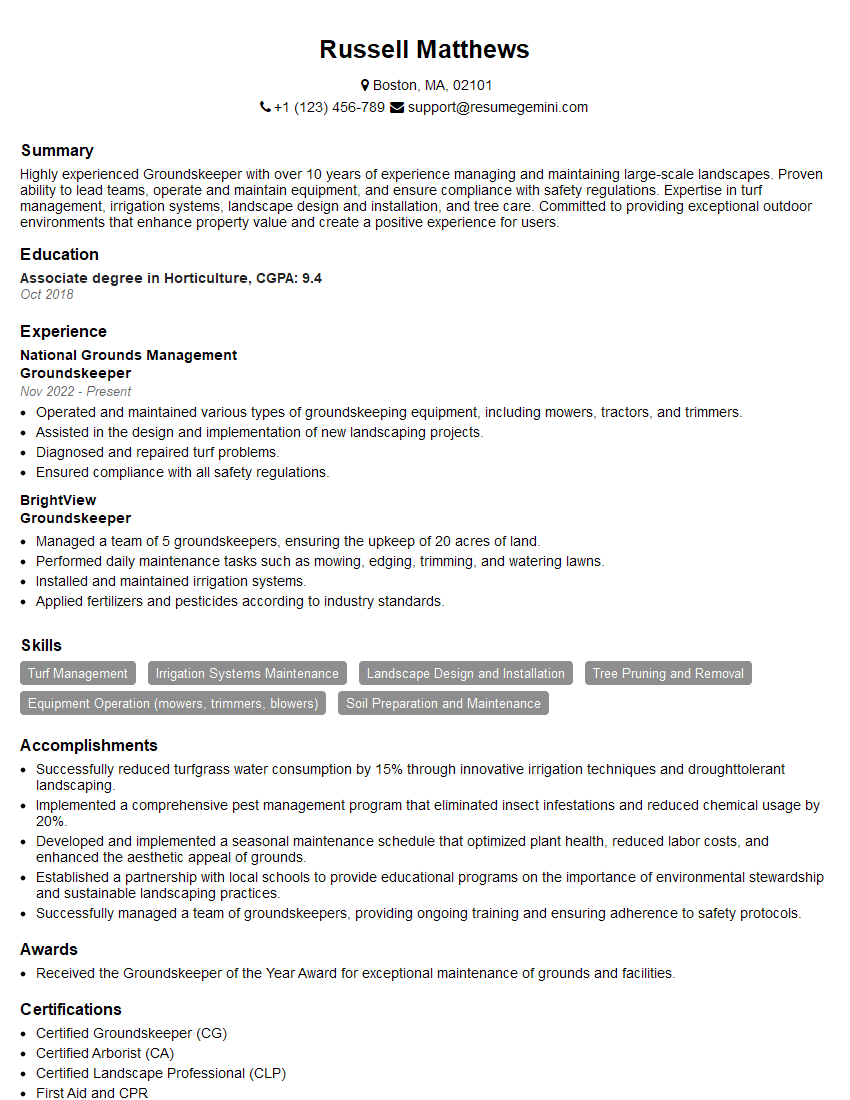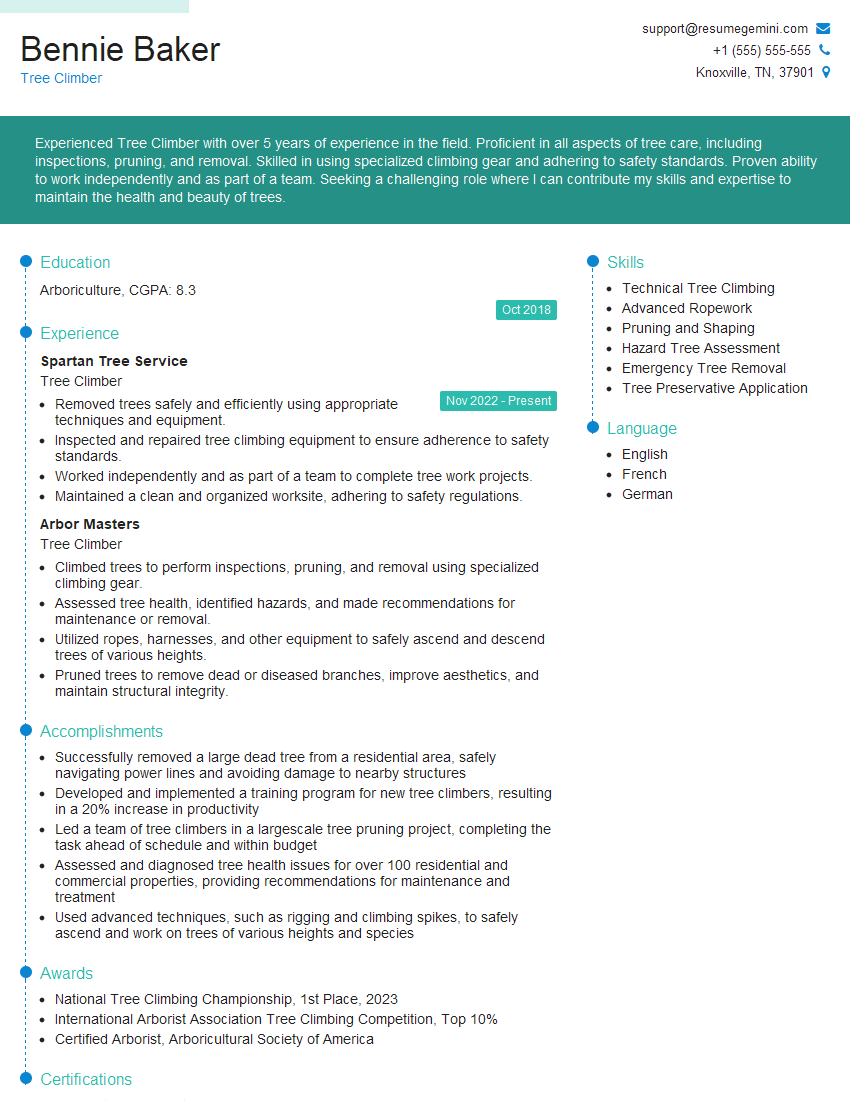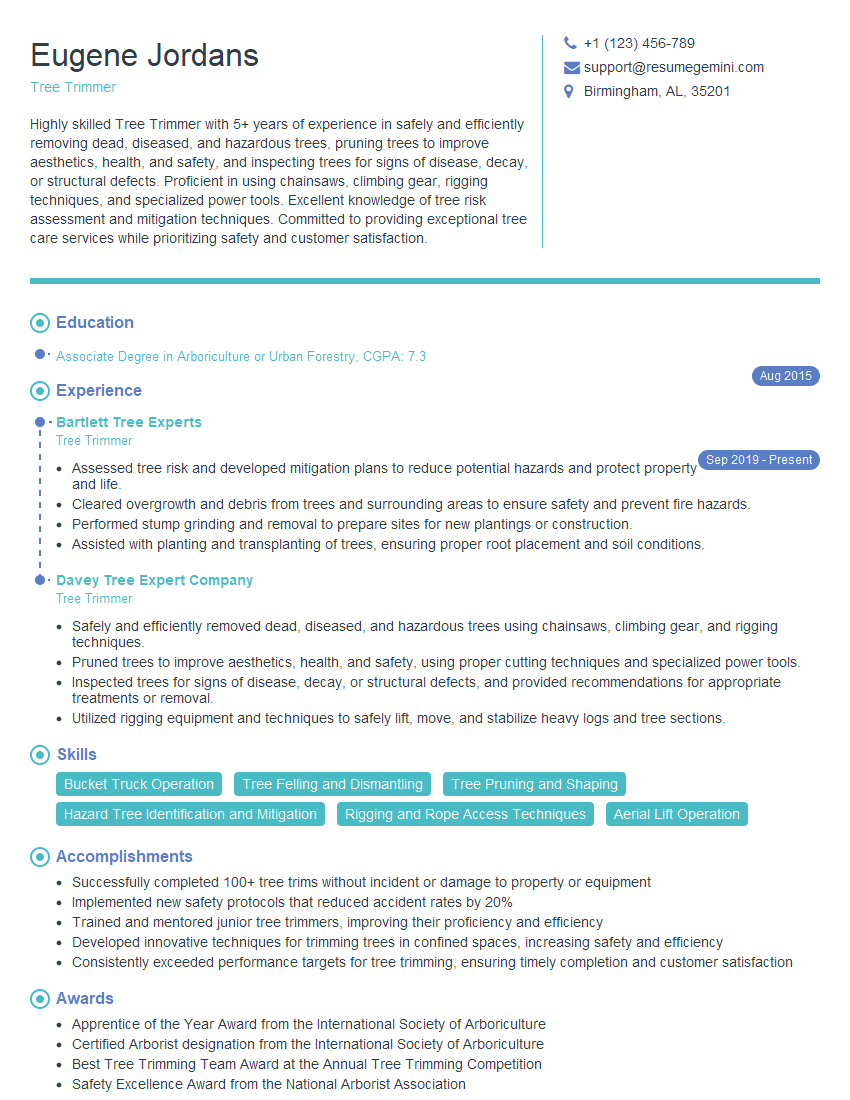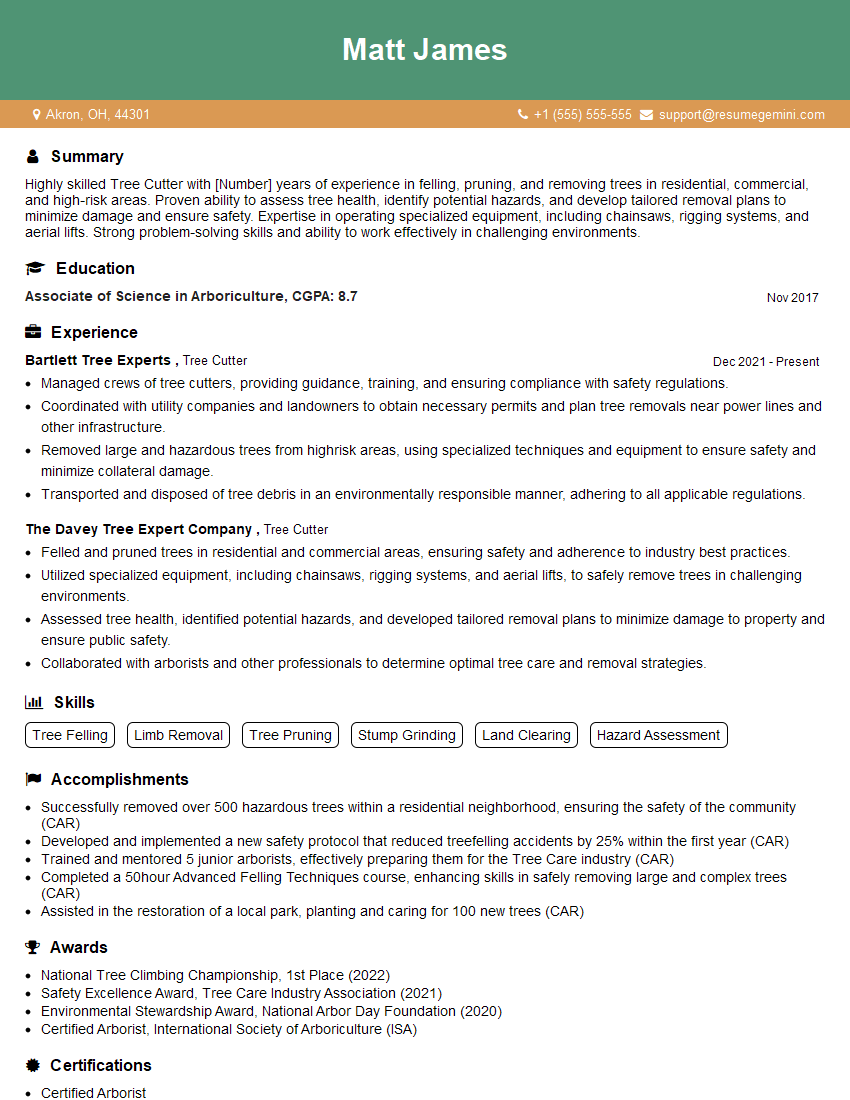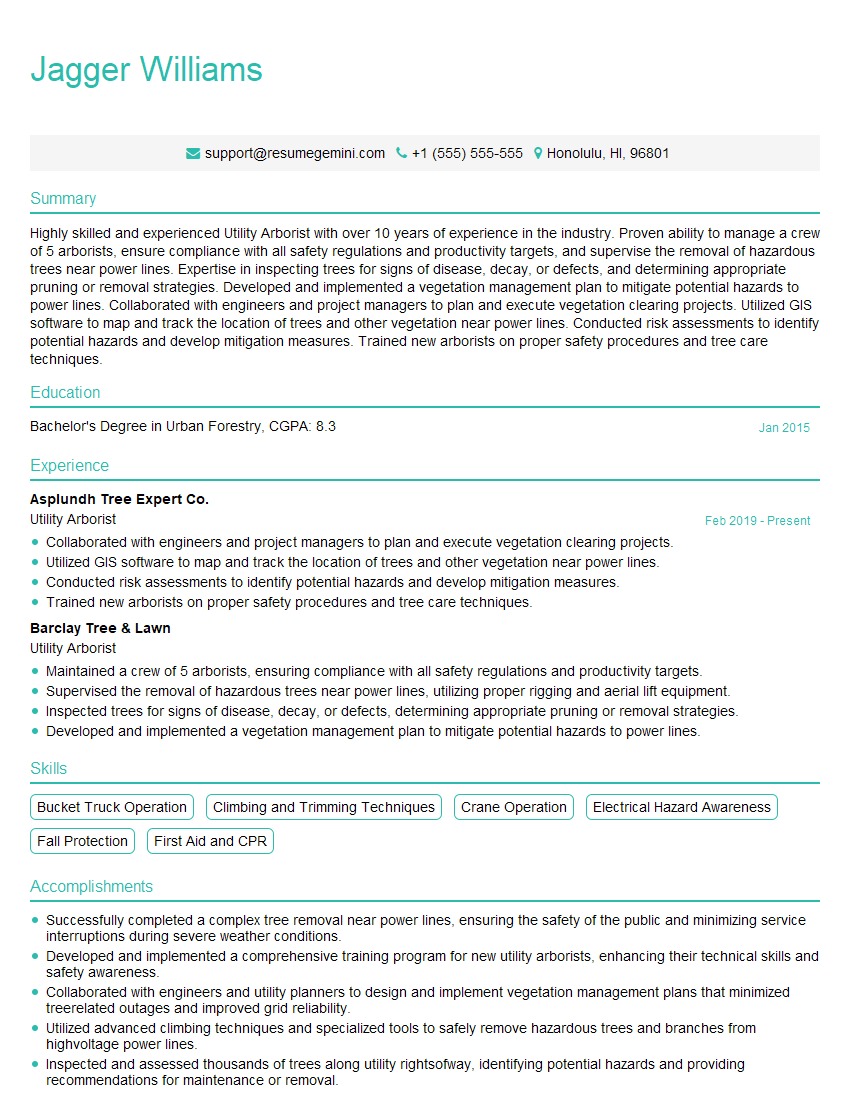Every successful interview starts with knowing what to expect. In this blog, we’ll take you through the top Tree Cutting interview questions, breaking them down with expert tips to help you deliver impactful answers. Step into your next interview fully prepared and ready to succeed.
Questions Asked in Tree Cutting Interview
Q 1. What safety measures do you employ when operating a chainsaw?
Chainsaw safety is paramount. It’s not just about following rules; it’s about developing a safety-first mindset. My approach is multifaceted and begins long before the chainsaw is even started.
- Personal Protective Equipment (PPE): This is non-negotiable. I always wear chaps (chainsaw protective trousers), safety boots with steel toes and ankle support, gloves with cut-resistant properties, eye protection (goggles or a face shield), and hearing protection. A helmet is also crucial, especially when working near overhead branches.
- Chainsaw Maintenance: A well-maintained chainsaw is a safe chainsaw. I regularly check the chain sharpness, lubrication, and overall condition. A dull or improperly tensioned chain is more likely to kickback, a major safety hazard.
- Proper Technique: I use a firm grip, keeping my body balanced and avoiding reaching or overextending. I always maintain a safe distance from the cutting area, especially when bucking (cutting a felled log into smaller pieces).
- Work Area Assessment: Before starting any work, I carefully assess the surroundings. This includes identifying potential hazards like overhead power lines, underground utilities, and obstacles that could cause me to lose my footing. I clear the area of debris and ensure a safe escape route is available.
- Emergency Preparedness: I always work with a buddy whenever possible. In case of an accident, a second person can provide immediate assistance and call for emergency services. I also have a first-aid kit readily available.
For example, on a recent job, a branch unexpectedly shifted during felling. Because I was wearing my chaps and had a secure footing, I was able to react safely and avoid injury. This highlights the critical role of PPE and proper technique.
Q 2. Explain the difference between crown reduction and crown thinning.
Crown reduction and crown thinning are both pruning techniques aimed at managing the size and shape of a tree’s crown, but they achieve this in different ways. Imagine the crown as a hairstyle – reduction is like getting a shorter cut, while thinning is like getting layers added.
Crown Reduction: This involves shortening the main branches of a tree, reducing its overall height and spread. It’s usually done to decrease the tree’s size to fit a specific space or reduce its wind resistance. It’s important to note that heavy crown reduction can stress the tree and should only be done by experienced arborists using appropriate techniques to avoid creating weak points in the structure.
Crown Thinning: This involves removing smaller branches within the crown, typically those that are crowded or overlapping. This improves light penetration within the crown, increases air circulation, and reduces the weight of the crown, making it more resilient to wind and snow damage. It helps maintain the tree’s natural shape while improving its health and vigor.
Think of it this way: crown reduction makes the tree smaller, while crown thinning makes the tree healthier and more robust.
Q 3. Describe your experience with different tree felling techniques.
I’m proficient in several tree felling techniques, selecting the best approach based on factors like tree species, size, location, and surrounding environment. Safety is always the primary consideration.
- The Notch Cut and Back Cut: This is a classic technique for controlled felling. A notch is cut on the side the tree is to fall, followed by a back cut, carefully controlling the direction and speed of the fall. This method requires precision and understanding of tree lean, weight distribution, and potential obstacles.
- Humboldt Cut (or Open-Face Cut): Used for trees leaning away from the direction of fall, this involves a single undercut followed by a controlled back cut. Requires precise execution to prevent uncontrolled tree movement.
- Directional Felling with rigging: For large or difficult-to-access trees, we use rigging techniques. This involves placing ropes and pulleys to control the direction and speed of the fall, often using specialized equipment like climbing gear and winches. This minimizes risk and enhances precision.
For instance, when felling a large oak near a house, I’d employ the directional felling with rigging technique, strategically placing ropes and using wedges to guide the fall away from the structure. For a smaller tree in an open area, the notch and back cut method might suffice.
Q 4. How do you assess the risk of a tree falling?
Assessing the risk of a tree falling involves a thorough evaluation of several factors. It’s not just about looking at the tree; it’s about understanding its context.
- Tree Condition: I check for signs of decay, disease, structural weakness (e.g., cavities, cracks, leaning), and evidence of insect infestation. I use specialized tools like increment borers to assess internal wood quality.
- Site Conditions: The surrounding environment plays a significant role. I consider the soil type, slope, nearby structures, power lines, and the presence of other trees that could affect the fall. Wind speed and direction are also critical factors.
- Tree Species: Different species have varying structural characteristics. Some are more prone to breakage or decay than others. This knowledge influences my risk assessment.
- Visual Inspection: I conduct a visual inspection, scrutinizing the crown, trunk, and root system for any signs of distress or damage. A careful assessment of the tree’s overall stability is paramount.
For example, a seemingly healthy tree on a steep slope during a strong wind presents a much higher risk than a healthy tree in stable ground during calm weather. The risk assessment is a holistic process that considers all these elements.
Q 5. What are the common signs of tree disease or infestation?
Recognizing signs of tree disease and infestation is crucial for ensuring both tree health and safety. Early detection is key to effective management.
- Changes in Foliage: Discoloration, wilting, thinning, or unusual leaf growth patterns can indicate stress, disease, or infestation.
- Cankers and Galls: These are abnormal growths on the branches or trunk, often indicating infection.
- Insect Activity: The presence of insects, insect borings, or frass (insect excrement) suggests infestation.
- Unusual fruiting bodies: Fungi can cause various diseases, and their fruiting bodies (mushrooms) are often visible signs of infection.
- Root Damage: Exposed roots or signs of root decay can significantly compromise the tree’s stability.
For instance, a sudden browning of leaves in only one section of a tree’s crown could point to a localized infection. Identifying such signs early helps in implementing timely treatments or removal decisions.
Q 6. How do you determine the best approach for removing a hazardous tree?
Removing a hazardous tree requires a carefully planned approach that prioritizes safety. The method chosen depends entirely on the tree’s condition, location, and surrounding environment.
- Risk Assessment: A detailed risk assessment is the first step, identifying all potential hazards and the likelihood of damage or injury during removal.
- Method Selection: The chosen method could involve felling, dismantling (taking the tree down piece by piece), or a combination of both. Difficult situations may require specialized techniques and equipment.
- Protective Measures: Appropriate safety measures, including the use of PPE, traffic control (if necessary), and the protection of nearby structures, must be in place.
- Professional Expertise: In many cases, it’s crucial to involve qualified and experienced arborists, especially for complex removals that pose significant risks.
Imagine a large, diseased tree overhanging a building. A direct felling would be extremely risky. In this scenario, I’d likely opt for a dismantling approach, carefully removing sections of the tree to minimize the risk of damage.
Q 7. What are your experiences with different types of climbing equipment?
My experience with climbing equipment is extensive, and I’m proficient in using various types of gear for safe and efficient tree access.
- Climbing Spikes and Gaffs: While less common now, I’m skilled in their use for accessing smaller trees in certain situations. This requires significant expertise and is only safe for trained climbers.
- Saddle and Climbing Ropes: My preferred method uses a climbing saddle connected to a rope system, allowing for controlled ascent and descent. I’m experienced with various rope techniques, including the use of friction hitches and ascenders.
- Throwline and Ascenders: I use a throwline to get a rope over a high branch, followed by ascenders to create a safe system for climbing and work positioning.
- Harness and Safety Systems: I always use a properly fitted harness and incorporate redundant safety systems like backups and additional lanyards to minimize fall risk.
For example, during a crown reduction job on a tall maple tree, I used a climbing saddle and rope system to reach the upper canopy, allowing me to accurately prune branches while maintaining complete control and safety throughout the operation.
Q 8. Describe your experience with rigging and lowering large tree sections.
Rigging and lowering large tree sections is a critical aspect of safe and efficient tree removal, particularly in urban environments where space is limited. It involves strategically planning the felling and dismantling of a tree into manageable sections, using ropes, pulleys, and other specialized equipment to control their descent. Think of it like a controlled, reverse-construction project.
My experience encompasses working with various rigging techniques, from basic single-rope systems to more complex multi-rope configurations used for extremely large or awkwardly shaped sections. I’m proficient in knot tying (e.g., bowline, clove hitch, etc.), assessing weight distribution, and choosing the right equipment based on the specific circumstances of the job. For instance, I’ve successfully lowered a large oak limb overhanging a house using a three-point rigging system, ensuring it landed safely away from the structure. Another time, I used a snatch block and a pulley system to delicately lower a massive redwood section over a powerline, minimizing any risk of damage.
Safety is paramount. Before commencing any rigging operation, a thorough risk assessment is conducted, identifying potential hazards and developing a mitigation strategy. This includes choosing appropriate personal protective equipment (PPE) such as helmets, harnesses, and gloves.
Q 9. How familiar are you with local and national tree care regulations?
Staying compliant with local and national tree care regulations is essential for responsible tree work. I’m intimately familiar with both the state and federal regulations governing tree felling, pruning, and other related activities. This includes understanding regulations regarding protected tree species, right-of-way clearances, and environmental protection.
My knowledge extends to obtaining necessary permits, working within established safety protocols, and understanding liability issues. For example, I know the specific regulations governing tree work near power lines and will always coordinate with utility companies before starting a job near these hazards. I also keep abreast of any changes in legislation through professional development and industry publications to ensure our operations remain fully compliant. Understanding these regulations isn’t just about avoiding penalties, it’s about being a responsible steward of our environment and ensuring the safety of the public and my crew.
Q 10. Explain your knowledge of different tree species and their specific care requirements.
Understanding different tree species and their specific care requirements is fundamental to successful tree care. This knowledge informs all aspects of my work, from pruning techniques to disease and pest management. For example, I know that the brittle nature of certain species, like some maples, requires a different pruning approach than the more flexible branches of an oak.
My knowledge base includes identifying various species, understanding their growth habits, recognizing signs of disease or pest infestation, and determining appropriate treatment methods. For instance, I know the specific vulnerabilities of elm trees to Dutch elm disease and the appropriate steps to prevent its spread. I’ve also worked extensively with a variety of species including Oaks, Maples, Pines, and various fruit trees, each requiring unique care strategies.
This understanding is crucial for maintaining tree health, enhancing their longevity, and ensuring public safety. Misunderstanding a species’ needs can lead to unnecessary damage or even fatal consequences.
Q 11. What is your experience with stump grinding?
Stump grinding is a common practice following tree removal, leaving a smooth, level surface ideal for landscaping. I’ve extensive experience operating various stump grinders, from smaller, more maneuverable machines suitable for residential settings to larger, more powerful units for commercial projects. I’m adept at preparing the area, safely operating the equipment, and achieving a consistent grind depth to meet client expectations.
Safety is a top priority. Before starting, I ensure that the area is clear of obstructions and that proper safety precautions are taken, including using appropriate personal protective equipment (PPE). I’m familiar with different grinder types, including those with various cutting styles and tooth configurations, selecting the right tool for the specific job and tree type. I’ve handled everything from small, easily accessible stumps to larger, more complex ones requiring multiple passes and specialized techniques.
Q 12. How do you manage challenging weather conditions during tree work?
Weather significantly impacts tree work. Safety is my top priority in challenging conditions. High winds, rain, snow, and ice create hazardous situations. My approach involves careful assessment and proactive measures. Strong winds, for example, necessitate delaying or postponing operations to prevent accidents. Rain can make working at heights very dangerous due to slippery conditions.
I use weather forecasts to plan work schedules, choosing suitable days for operations and carefully considering wind speed and direction. Specific protocols exist for various weather conditions; for instance, work often ceases completely during severe thunderstorms. I’m adept at risk mitigation strategies, including using specialized equipment (e.g., securing ropes and equipment) and adjusting techniques to account for weather-related obstacles.
Q 13. Describe your experience with aerial lifts and bucket trucks.
Aerial lifts and bucket trucks are valuable tools for accessing higher branches, allowing for efficient and safe pruning or removal. I’m fully certified and experienced in operating both, emphasizing safe practices and regular maintenance checks. Before each use, I perform a thorough inspection to ensure everything is functioning correctly. Proper training and adherence to safety protocols are crucial for safe operation.
My experience includes operating various sizes of aerial lifts and bucket trucks, adapting my techniques depending on the size and type of equipment and the specific job requirements. I understand the limitations of each machine and always prioritize safe working practices, ensuring the stability of the lift and the secure attachment of safety harnesses. I always follow manufacturer guidelines and company safety protocols for both pre-operation checks and operational procedures.
Q 14. What is your experience with preventative tree maintenance?
Preventative tree maintenance focuses on proactive care to prevent future problems, minimizing the need for extensive and potentially dangerous interventions. This approach involves regular inspections, pruning to enhance tree structure and health, and addressing potential issues like disease or pest infestations before they become major concerns.
My preventative maintenance strategies include assessing overall tree health, identifying and removing dead or diseased branches, and performing crown cleaning to improve air circulation and sunlight penetration. I also advise clients on proper fertilization techniques, watering schedules, and strategies to protect trees from environmental stress. Early identification and mitigation of problems, through regular inspections and preventative pruning, dramatically reduces the risk of future hazards and prolongs the lifespan of the tree.
Preventative maintenance is cost-effective in the long run, avoiding the need for more extensive and costly emergency repairs.
Q 15. How do you handle unexpected situations or emergencies during tree work?
Unexpected situations are the norm, not the exception, in tree work. My approach prioritizes preparedness and a systematic response. First, I conduct thorough risk assessments before any job begins, identifying potential hazards like unstable branches, power lines, or difficult terrain. This helps anticipate problems. If an unexpected event occurs, such as a branch falling in an unforeseen direction, my immediate action is to ensure the safety of myself and my crew. We’ve established clear communication protocols – a simple hand signal system – to quickly react. We might immediately halt operations, reassess the situation, and adjust our techniques. For example, if a branch unexpectedly breaks during a felling, we’d utilize escape routes pre-determined in the risk assessment, using our protective gear (helmets, chaps, etc.). Regular training and drills, especially in emergency response scenarios, are crucial. We also maintain open communication with clients, keeping them informed of any unexpected developments and any changes in the plan.
Career Expert Tips:
- Ace those interviews! Prepare effectively by reviewing the Top 50 Most Common Interview Questions on ResumeGemini.
- Navigate your job search with confidence! Explore a wide range of Career Tips on ResumeGemini. Learn about common challenges and recommendations to overcome them.
- Craft the perfect resume! Master the Art of Resume Writing with ResumeGemini’s guide. Showcase your unique qualifications and achievements effectively.
- Don’t miss out on holiday savings! Build your dream resume with ResumeGemini’s ATS optimized templates.
Q 16. Describe your experience with tree planting and transplanting.
Tree planting and transplanting are essential parts of arboriculture, requiring a delicate touch and understanding of tree biology. My experience includes planting everything from small saplings to mature trees, each requiring a different approach. For saplings, the focus is on proper soil preparation, ensuring adequate drainage and nutrient-rich soil. The planting hole should be twice the width of the root ball, allowing for easy root expansion. Careful handling of the root system is paramount – avoid damaging delicate roots. Mature tree transplanting involves far more complex techniques. It often includes root ball excavation and careful wrapping of the root system to minimize stress during transportation and replanting. We use specialized equipment like cranes and trucks to move larger trees. Post-transplant care is crucial, involving regular watering, mulching, and potentially staking to help the tree establish itself in its new location. I’ve successfully transplanted several mature oaks and maples, using these techniques, ensuring high survival rates.
Q 17. How do you ensure the safety of the public during tree removal operations?
Public safety is my top priority. Before any tree removal, a detailed safety plan is developed and implemented. This includes establishing a safety zone, clearly marked with cones and caution tape, to keep the public at a safe distance. We consider factors like wind speed, tree lean, and potential drop zones. If necessary, we’ll utilize traffic control measures or even temporary road closures to minimize risk. We communicate with nearby residents and businesses beforehand, informing them of the operation’s timing and safety precautions. During the removal process, constant communication between the crew is vital, with clear signals and instructions. We use rigging techniques to control the direction of falling branches and the entire tree, directing it away from structures and people. Regular inspections of the worksite for any unexpected hazards, like broken branches or unstable debris, is also critical. Post-operation, we thoroughly inspect the area to ensure no hazards remain.
Q 18. What is your experience working with confined spaces around trees?
Confined space work around trees requires specialized skills and equipment. I have significant experience working in tight areas, often near buildings or other structures. This involves using smaller, more maneuverable equipment like smaller chainsaws and hand saws, and employing specialized rigging techniques to carefully control the direction of falling branches or sections of the tree. My team and I are trained in confined space safety protocols, including the use of proper personal protective equipment (PPE) and communication systems. We frequently utilize ropes, pulleys, and winches for precise tree section removal in these situations. Careful planning and risk assessment are even more crucial in these scenarios to anticipate and mitigate potential hazards. A recent project involved removing a large branch overhanging a neighbor’s house – careful planning and specialized rigging allowed us to safely remove the branch without damaging the house.
Q 19. Explain your knowledge of tree biology and physiology.
A strong understanding of tree biology and physiology is fundamental to safe and effective tree work. This includes knowledge of tree species, their growth patterns, and their susceptibility to diseases and pests. I understand how environmental factors like soil type, water availability, and sunlight affect tree health and growth. Knowing the different parts of a tree (roots, trunk, branches, leaves) and how they interact is critical in planning cuts and predicting how a tree will react to them. For example, understanding the stress points in a tree allows me to make cuts that minimize the risk of dangerous reactions. I am familiar with common tree diseases and pests and can identify signs of infestation or disease, advising on appropriate treatment or removal if necessary. This knowledge is essential for determining the best approach for pruning, removing, or transplanting a tree.
Q 20. How do you maintain your chainsaw and other equipment?
Proper chainsaw maintenance is crucial for safety and efficiency. After every use, I clean the saw, removing sawdust and debris. Regular sharpening of the chain is essential for clean cuts and prevents kickback, a major safety hazard. I use a sharpening file and gauge to maintain the correct chain profile. I also lubricate the bar and chain with high-quality bar oil to prevent excessive wear and tear. The air filter is regularly cleaned or replaced, ensuring optimal engine performance. For other equipment, like ropes and harnesses, regular inspections are done for wear and tear, ensuring they’re in good working condition before each job. Preventative maintenance, such as tightening bolts and checking for damage, extends the life of the equipment and ensures safe operation. Following the manufacturer’s instructions and keeping records of maintenance schedules is a standard practice.
Q 21. What is your experience with using specialized tree cutting tools?
My experience encompasses a wide range of specialized tree cutting tools. Beyond the standard chainsaw, I’m proficient with climbing gear (ropes, ascenders, descenders, harnesses), aerial lifts, and specialized pruning saws for delicate work. I’m skilled in using rigging equipment, including ropes, pulleys, and winches, for controlled felling and branch removal. I’m also familiar with using different types of cutting equipment depending on the tree species and job requirements. For instance, I’d use a smaller, more precise saw for pruning delicate branches of an ornamental tree, compared to a larger chainsaw for felling a larger tree. Specialized tools are essential for efficient and safe tree work, minimizing risks and ensuring quality results. Training and certifications related to using this specialized equipment are critical components of my professional expertise.
Q 22. Describe your experience documenting tree work and generating reports.
Thorough documentation is paramount in tree work. It protects both the client and the arborist. My approach involves a multi-step process. First, I conduct a detailed pre-work assessment, noting tree species, size, health, location, surrounding structures, and potential hazards. This is often documented with photos and sketches, sometimes using specialized software for creating scaled drawings. During the work itself, I maintain a daily log detailing activities, equipment used, personnel involved, and any unforeseen circumstances. Post-work, I generate a comprehensive report including before-and-after photos, a summary of work performed, a detailed cost breakdown, and recommendations for future tree care. For example, on a recent project involving the removal of a large oak near a power line, my documentation included high-resolution images illustrating the proximity to the line, detailed measurements of the tree, and a step-by-step account of the rigging techniques used to ensure the safe removal without power disruption. This level of detail safeguards against disputes and provides valuable records for insurance purposes or future reference.
Q 23. How do you communicate effectively with clients and colleagues regarding tree work?
Effective communication is the cornerstone of successful tree work. I prioritize clear, concise, and jargon-free language when interacting with both clients and colleagues. With clients, I explain the assessment findings, proposed solutions, potential risks, and cost estimates in a straightforward manner, answering questions patiently and thoroughly. I use visual aids like photos and diagrams whenever possible to enhance understanding. With colleagues, I emphasize precise communication during the actual tree work, using clear hand signals and radio communication to coordinate our actions safely and efficiently. For instance, when removing a large tree in a confined space, precise communication between the climber and ground crew is essential to prevent accidents. We use pre-determined signal codes for specific maneuvers and report any changes or potential hazards immediately. Open communication fosters teamwork and ensures a safe and productive work environment.
Q 24. How do you prioritize tasks when working on multiple tree removal projects?
Prioritizing multiple tree removal projects requires a systematic approach. I utilize project management techniques, starting by assessing each project based on factors such as urgency, complexity, client needs, and potential hazards. I assign each project a priority level (high, medium, low) and create a schedule that allows for efficient resource allocation. I often use Gantt charts or other project management software to visualize deadlines and dependencies. For example, I might prioritize an emergency tree removal after a storm over a scheduled pruning job, as the former presents immediate safety risks. Within each project, I break down tasks into smaller, manageable steps to streamline the process and track progress effectively. Regular review and adaptation of this schedule are crucial to accommodate unexpected events or changing priorities.
Q 25. What are your strategies for dealing with difficult tree access locations?
Difficult tree access locations necessitate creative problem-solving and a focus on safety. My strategies include thorough site assessment, determining the best approach (e.g., using specialized equipment like cranes, ropes and pulleys, or a combination), and utilizing advanced climbing techniques where appropriate. For example, when faced with a large tree in a densely populated residential area with limited access, I might utilize directional felling techniques, dropping the tree in a predetermined direction using ropes and pulleys. Another example could be using a crane to lift large sections of a tree to avoid damage to nearby property. Risk assessment is crucial; I always consider the safest methods while maintaining efficiency. Safety measures like using appropriate personal protective equipment (PPE) and having a robust communication system are paramount in challenging environments.
Q 26. How do you comply with OSHA regulations related to tree care?
Compliance with OSHA regulations is non-negotiable. Our team undergoes regular safety training that covers all relevant OSHA standards for arboriculture. This includes proper use of PPE (helmets, harnesses, eye protection, etc.), safe handling of equipment (chainsaws, ropes, rigging), hazard communication, and emergency response procedures. We meticulously inspect our equipment before each job to ensure everything is in good working order and perform pre-job briefings to address specific risks. We maintain detailed records of training, inspections, and incident reports. Our commitment to safety isn’t just about compliance; it’s about creating a culture of safety that protects our team and clients. For instance, we follow strict guidelines for using aerial lifts and ensure proper spotters are in place during every operation. Our team understands that safety isn’t just a policy but a mindset.
Q 27. Explain your experience with damage assessment after a storm or other event.
Post-storm damage assessment is a critical skill. I start by conducting a thorough survey of the affected area, visually inspecting trees for structural damage, broken limbs, leaning trees, or signs of root uprooting. I document my findings with photographs, notes, and measurements, carefully assessing the risk each damaged tree poses to property and people. I prioritize trees that pose an immediate threat, and then systematically assess others. I might use specialized equipment to assess the structural integrity of larger trees. Based on my findings, I prepare a detailed report outlining the damage, prioritized repairs, and cost estimates. This report is crucial for insurance claims and facilitates informed decision-making regarding tree removal or rehabilitation. For instance, following a significant ice storm, my assessment helped identify several trees at risk of falling onto a nearby school, allowing for prompt removal and preventing potential harm.
Q 28. Describe your experience with working on large-scale tree removal projects.
Experience with large-scale projects involves meticulous planning and coordination. I have worked on projects involving the removal of hundreds of trees, often requiring collaboration with multiple crews, equipment operators, and potentially other contractors. My approach emphasizes detailed project planning, which includes a comprehensive site survey, detailed work breakdown structure (WBS), resource allocation, scheduling, and safety protocols. Clear communication is essential – we use daily briefings, radio communication, and progress reports to maintain coordination. Safety is always paramount, so we carefully manage potential hazards and ensure everyone follows established safety procedures. For example, in a large-scale clearing project for a new housing development, we carefully planned the felling direction of each tree to avoid damaging adjacent structures or interfering with ongoing construction activities. This requires meticulous planning and ongoing communication to ensure success.
Key Topics to Learn for Your Tree Cutting Interview
- Tree Identification and Assessment: Understanding different tree species, their growth habits, and identifying potential hazards (disease, decay, structural weakness) is crucial for safe and effective cutting.
- Felling Techniques: Mastering various felling techniques, including the use of wedges and felling levers, ensures controlled and safe tree removal in different environments and conditions.
- Safety Procedures and Regulations: Thorough knowledge of safety regulations, personal protective equipment (PPE) usage, and emergency procedures is paramount for a successful and injury-free career.
- Equipment Operation and Maintenance: Familiarity with chainsaws, climbing gear, and other equipment, including their safe operation and preventative maintenance, is essential for efficiency and safety.
- Site Preparation and Cleanup: Understanding site preparation before felling, including assessing the area for hazards and obstacles, and proper cleanup after the job demonstrates professionalism and environmental awareness.
- Pruning and Trimming Techniques: Knowing how to prune and trim trees safely and effectively, minimizing damage to the tree and surrounding environment, showcases your skill and precision.
- Problem-Solving and Decision-Making: Interviewers will assess your ability to handle unexpected situations, make sound judgments under pressure, and adapt your techniques to varying challenges presented by different trees and environments.
- Environmental Considerations: Demonstrate your understanding of sustainable forestry practices, minimizing environmental impact, and adhering to local regulations related to tree removal.
Next Steps
Mastering the art of tree cutting opens doors to a rewarding career with excellent growth potential. To maximize your job prospects, it’s crucial to present yourself effectively. Creating an ATS-friendly resume is key to getting your application noticed by potential employers. We strongly recommend using ResumeGemini to build a professional and impactful resume that highlights your skills and experience in tree cutting. ResumeGemini provides examples of resumes tailored to the tree cutting industry, ensuring your application stands out from the competition.
Explore more articles
Users Rating of Our Blogs
Share Your Experience
We value your feedback! Please rate our content and share your thoughts (optional).
What Readers Say About Our Blog
Hello,
We found issues with your domain’s email setup that may be sending your messages to spam or blocking them completely. InboxShield Mini shows you how to fix it in minutes — no tech skills required.
Scan your domain now for details: https://inboxshield-mini.com/
— Adam @ InboxShield Mini
Reply STOP to unsubscribe
Hi, are you owner of interviewgemini.com? What if I told you I could help you find extra time in your schedule, reconnect with leads you didn’t even realize you missed, and bring in more “I want to work with you” conversations, without increasing your ad spend or hiring a full-time employee?
All with a flexible, budget-friendly service that could easily pay for itself. Sounds good?
Would it be nice to jump on a quick 10-minute call so I can show you exactly how we make this work?
Best,
Hapei
Marketing Director
Hey, I know you’re the owner of interviewgemini.com. I’ll be quick.
Fundraising for your business is tough and time-consuming. We make it easier by guaranteeing two private investor meetings each month, for six months. No demos, no pitch events – just direct introductions to active investors matched to your startup.
If youR17;re raising, this could help you build real momentum. Want me to send more info?
Hi, I represent an SEO company that specialises in getting you AI citations and higher rankings on Google. I’d like to offer you a 100% free SEO audit for your website. Would you be interested?
Hi, I represent an SEO company that specialises in getting you AI citations and higher rankings on Google. I’d like to offer you a 100% free SEO audit for your website. Would you be interested?
good
